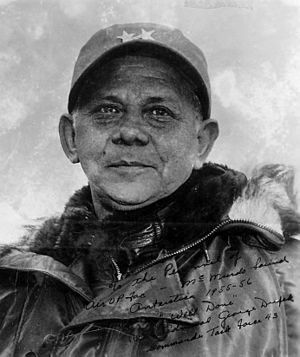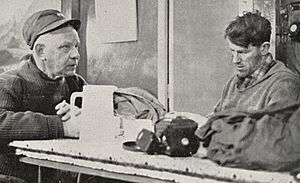George J. Dufek facts for kids
Quick facts for kids
George John Dufek
|
|
|---|---|
 |
|
| Born | February 10, 1903 Rockford, Illinois |
| Died | February 10, 1977 (aged 74) Bethesda, Maryland |
| Allegiance | |
| Service/ |
|
| Years of service | 1921–1959 |
| Rank | |
| Commands held | USS Bogue USS Antietam |
| Battles/wars | World War II Korean War |
| Awards | Distinguished Service Medal (2) Legion of Merit (2) Croix de guerre Légion d'honneur |
| Other work | Director, Mariners' Museum, Newport News, Virginia |
George John Dufek (born February 10, 1903, in Rockford, Illinois – died February 10, 1977, in Bethesda, Maryland) was an American Navy officer. He was also a naval aviator, meaning he flew planes for the Navy. Dufek was a well-known expert on the polar regions.
He served in both World War II and the Korean War. In the 1940s and 1950s, he spent a lot of time in Antarctica. He worked with Admiral Byrd, another famous explorer. Later, Dufek led U.S. programs in the South Polar regions. After retiring from the Navy in 1959, he became the director of the Mariners' Museum in Newport News, Virginia.
Contents
George Dufek was born in Rockford, Illinois. In high school, he joined the Reserve Officer Training Corps (ROTC). This program helps students prepare for military service. In 1921, he was accepted into the U.S. Naval Academy in Annapolis, Maryland.
After graduating in 1925, he became an ensign, which is a junior officer rank. He started his Navy career on the battleship USS Maryland. Later, he served on the submarine USS S-39. He was promoted to lieutenant (junior grade) in 1928.
In 1932, Dufek began flight training at the Naval Air Station Pensacola, Florida. He became a naval aviator in 1933. After that, he worked as a navigator and executive officer on three different ships. He was promoted to lieutenant in 1935. In 1938, he was assigned to the aircraft carrier USS Saratoga.
World War II and Korean War
During World War II, Dufek commanded a flight training squadron. He was also a senior naval aviator in Algeria during the invasion of North Africa. He helped plan the invasions of Sicily and Salerno. Later, he helped plan the invasion of southern France.
In September 1944, he took command of the escort carrier USS Bogue. On April 24, 1945, his ship and its escorts sank the U-546. This was the last of 13 submarines sunk by the Bogue during the war.
During the Korean War, Dufek commanded the aircraft carrier USS Antietam. He was in charge from January 1951 to May 1952. The Antietam operated off the coast of Korea and earned four battle stars for its service.
After the Korean War, Dufek commanded a naval base on Kwajalein Atoll in the Pacific. His last command was the Naval Air Station Whidbey Island in Oak Harbor, Washington.
Dufek retired from the Navy on June 30, 1955. He was promoted to the rank of rear admiral on the same day. This was in recognition of his achievements during the wars. He continued to serve on active duty to take part in Operation Deep Freeze.
Exploring Antarctica
With Admiral Byrd
In 1939, George Dufek, then a lieutenant, joined Rear Admiral Richard E. Byrd's third expedition to Antarctica. He served as the navigator of the USS Bear, which was the main ship of the expedition. Dufek flew many hours exploring the South Polar continent. For his work, he received the Antarctic Expedition Medal.
Operation Highjump
After World War II, Dufek became the chief staff officer for a U.S. Navy and Coast Guard team. Their mission was to set up weather bases in the polar regions. He took part in Operation Highjump, a Navy expedition to Antarctica led by Admiral Byrd. Dufek commanded the Eastern Group of ships during this operation.
During Operation Highjump, he made the first flight over the Thurston Peninsula. He also led the rescue of six people whose plane crashed in the same area. After a short time in Washington D.C., he returned to Antarctica in 1947. This time, he commanded a team that supplied existing weather stations and set up new ones near the Pole.
Operation Deep Freeze

In 1954, Dufek joined a special group planning the Navy's Operation Deep Freeze. This was a big scientific expedition to the South Pole. When the planning was done, Dufek was given command of Task Force 43. This large team had over 80 officers and 1,000 enlisted men. They also had three ice-breakers and three cargo ships. Their job was to provide logistics and support for the expedition.
Dufek's first ship for the operation was the cargo ship USS Arneb. Later, he moved his flag to the icebreaker USS Glacier. He was on the Glacier when it sailed all the way around the Antarctic continent.
The task force achieved many things. They set up bases on Ross Island and in Little America. On October 31, 1956, Admiral Dufek and a crew of six made history. They became the first Americans to set foot at the South Pole. They also planted the American flag there. They were the first people to land on the pole from the air.
On November 28, 1957, Dufek was present with a U.S. congressional delegation at a ceremony at McMurdo Sound. After Admiral Byrd passed away, Dufek was chosen to take his place. He became the supervisor of U.S. programs in the South Polar Regions.
George Dufek died in 1977, on his 74th birthday.
Places Named in His Honor
Several places in Antarctica were named after George Dufek to honor his contributions. These include:
- Dufek Coast
- Dufek Head
- Dufek Massif
- Dufek Mountain
Awards and Honors
Admiral George Dufek received many awards for his service and explorations:
- Navy Distinguished Service Medal (twice)
- Legion of Merit (twice)
- United States Antarctic Expedition Medal (1939–1941)
- American Defense Service Medal
- American Campaign Medal
- European-African-Middle Eastern Campaign Medal (with 4 battle stars)
- World War II Victory Medal
- Navy Occupation Medal (with "ASIA" clasp)
- National Defense Service Medal
- Korean Service Medal (with four battle stars)
- Antarctic Service Medal
- Chevalier of the Legion of Honor (France)
- Croix de Guerre (1939-1945) (France, with Palm)
- Korean Presidential Unit Citation
- United Nations Korea Medal
- Golden Plate Award, American Academy of Achievement, 1961
Dates of Rank
- Midshipman – August 16, 1921
- Ensign – June 4, 1925
- Lieutenant (junior grade) – June 4, 1928
- Lieutenant – June 30, 1935
- Lieutenant Commander – August 1, 1939
- Commander – August 1, 1942
- Captain – July 20, 1943
- Rear Admiral, Retired – June 30, 1955
Images for kids
See also
In Spanish: George J. Dufek para niños

